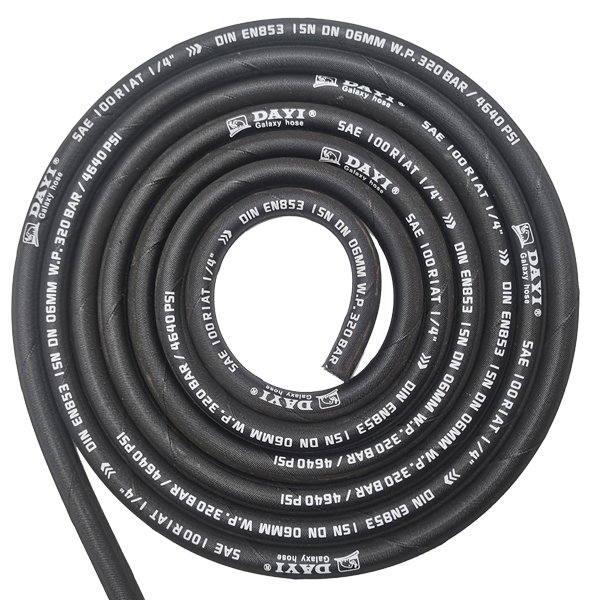335345435
Oct . 22, 2024 03:12 Back to list
Low Pressure Hydraulic Hose for Efficient Fluid Transfer and System Performance Optimization
Understanding Low Pressure Hydraulic Hoses A Comprehensive Guide
Hydraulic systems are an essential part of modern machinery and industrial applications, providing powerful means to transmit force and control equipment. Among the critical components of these systems are hydraulic hoses, which facilitate the transfer of hydraulic fluid. While there are different types of hydraulic hoses designed for varying pressures, this article will focus specifically on low pressure hydraulic hoses, their construction, applications, and best practices for use.
What are Low Pressure Hydraulic Hoses?
Low pressure hydraulic hoses are specifically designed to operate under lower pressure conditions, typically within a range of 0 to 3000 psi. They are used in applications where the pressure is not as high as that found in heavy-duty hydraulic systems. These hoses are made from flexible materials that allow for easy installation and maneuverability while providing sufficient strength to handle the hydraulic fluid being transferred.
Construction of Low Pressure Hydraulic Hoses
The construction of low pressure hydraulic hoses typically involves several layers, each serving a specific purpose
1. Inner Tube The innermost layer is made of rubber or thermoplastic that is compatible with the hydraulic fluid being transported. This layer must withstand the fluid's chemical properties and provide a tight seal to prevent leaks.
2. Reinforcement Layer Surrounding the inner tube, there is usually one or more reinforcement layers made of textile or steel wires. This layer provides the hose with strength and flexibility, enabling it to handle the operational forces while maintaining its shape.
3. Outer Cover The outermost layer protects the hose from external factors such as abrasion, UV rays, and chemicals. The cover is typically crafted from materials like synthetic rubber or thermoplastic that offer durability and weather resistance.
Applications of Low Pressure Hydraulic Hoses
Low pressure hydraulic hoses are utilized across various industries and applications, including
- Agriculture They are commonly found in agricultural machinery like tractors and combine harvesters, where they operate hydraulic systems for lifting, steering, and other functions.
low pressure hydraulic hose

- Construction In construction equipment, low pressure hoses are used for operating tools and machines, such as excavators and loaders, that require hydraulic power for various operations
.- Manufacturing Many manufacturing processes use hydraulic systems to position heavy loads, shape materials, or control machinery movements, all of which can benefit from low pressure hydraulic hoses.
- Automotive These hoses are prevalent in vehicle systems for power steering, brake systems, and other hydraulic-driven functions.
Best Practices for Using Low Pressure Hydraulic Hoses
To ensure the longevity and reliability of low pressure hydraulic hoses, consider the following best practices
1. Proper Selection Always choose the right hose for the specific application, considering factors such as temperature, fluid type, and pressure specifications. Using a hose not designed for the application can lead to premature failure or leaks.
2. Regular Inspection Conduct routine checks for signs of wear, damage, or leaks. Pay close attention to the outer cover for abrasions and the connections for any signs of fluid seepage.
3. Correct Installation Ensure hoses are installed without sharp bends or kinks, which can restrict flow and reduce the hose's lifespan. Use appropriate fittings to avoid stressing the hose.
4. Maintaining Cleanliness Hydraulic fluid contamination can be harmful. Ensure that hoses and connections remain clean during installation and operation to prevent particulates from entering the hydraulic system.
5. Environment Considerations Be mindful of the operating environment. Exposure to extreme temperatures, chemicals, or physical impacts can damage hoses. Use protective wraps or shields as necessary.
Conclusion
Low pressure hydraulic hoses play a critical role in the functionality of various machinery across multiple industries. Understanding their construction, application, and maintenance can lead to better performance and extended service life. By adhering to best practices, operators can ensure that their hydraulic systems operate smoothly and efficiently, ultimately enhancing productivity and safety in their operations. Whether in agriculture, construction, or manufacturing, low pressure hydraulic hoses are indispensable components that warrant careful attention and proper handling.
-
SAE 100 R17 Black Smooth Cover Hydraulic Hose
NewsMar.07,2025
-
SAE 100 R17 Black Smooth Cover Hydraulic Hose
NewsMar.07,2025
-
SAE 100 R17 Black Smooth Cover Hydraulic Hose
NewsMar.07,2025
-
SAE 100 R17 Black Smooth Cover Hydraulic Hose
NewsMar.07,2025
-
SAE 100 R17 Black Smooth Cover Hydraulic Hose
NewsMar.07,2025
-
steel wire braided hydraulic hose
NewsMar.07,2025



